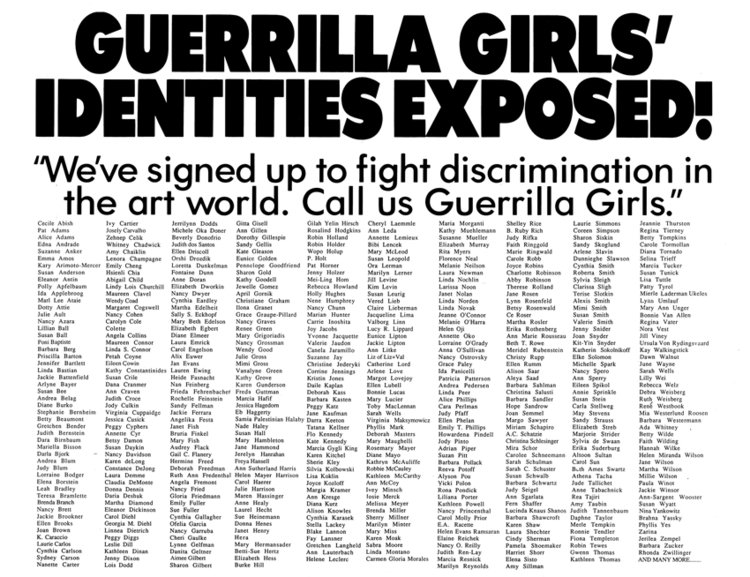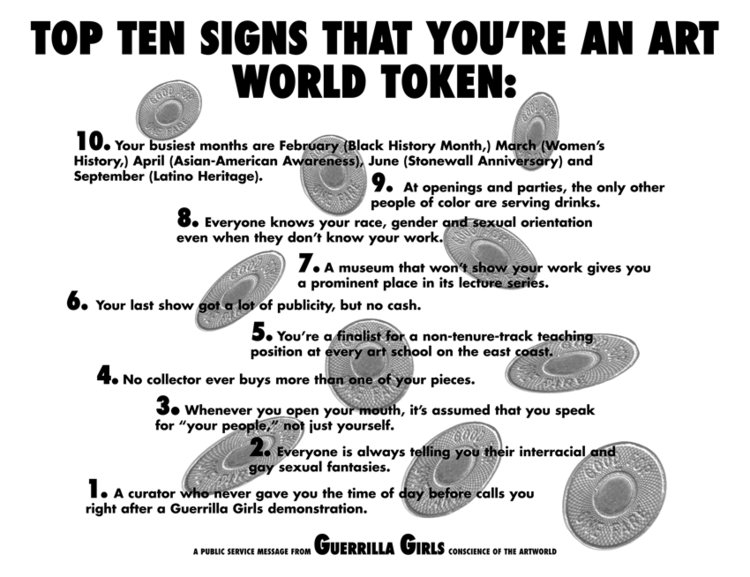Laura Knight in 5 Paintings: Capturing the Quotidian
An official war artist and the first woman to be made a dame of the British Empire, Laura Knight reached the top of her profession with her...
Natalia Iacobelli 2 January 2025
Since 1985, the anonymous feminist collective the Guerrilla Girls has been keeping tabs on the inequalities of the art world and beyond. The group has dubbed itself the “Conscience of the Art World,” through a range of media. Accomplished and outspoken, the Guerrilla Girls have been responsible for effecting change through relentless in-your-face tactics. Let’s look into their feminist interventions that have kept the art world on its toes.

Guerilla Girls, What do these artists have in common?, 1985. Collective’s website.
In 1985, the Guerrilla Girls sprang to action in New York City. The catalyst was an exhibition at the Museum of Modern Art (MoMA). The title of the exhibition was An International Survey of Recent Painting and Sculpture and Kynaston McShine was the curator. Of the 169 artists in this exhibition, only 13 were women artists. Only eight were artists of color. Confronted by the blatant oversight of this skewed survey, the curator said that anyone not in the exhibition should re-examine HIS career.
The suggestion that there was a dearth of good art by women and artists of color prompted protesters to demonstrate in front of the museum. But to no avail. The Women’s Caucus for the Arts had organized the protest. However, some of the women artists who participated, thought that the protests were ineffective. They correctly argued that they were not being heard. The barrier-breaking artists’ demand for equal rights for women and artists of color of the previous decade had made some headway. But clearly, more work was needed.

A group of frustrated women artists met shortly after the MoMA protests. They wanted to devise a direct course of action that the gatekeepers of the New York City art world could not ignore. Thus Guerrilla Girls was founded to expose the sexist and racist practices of the local contemporary art scene. This scene was driven by art market trends that rewarded few and excluded many. The anonymous group of feminists took aim at museums, art dealers, art collectors, galleries, auction houses and the art critics.
In the spirit of guerrilla warfare, a team of Guerrilla Girls wore masks to protect their identities. Overnight, they plastered posters attacking the contemporary art world across the SoHo gallery district of downtown New York City. These announced the arrival of an anonymous collective calling themselves the “Guerrilla Girls, The Conscience of the Art World.” This first round of posters took aim at the biased practices of art galleries and the complacency of artists (mostly men) these galleries represented. People took notice and the response was swift.
In today’s parlance, this inaugural poster campaign went viral. The Guerrilla Girls subsequently set up a post office box and phone number to receive inquiries, feedback and requests. Before long they became the focus of interest and outrage. They also received demands for more from institutions across this country and from around the world.

The Guerrilla Girls use humor to unpack uncomfortable truths and to make transparent the persistence of sexist and racist practices. Their combination of raw statistics, clever text and bold graphics underscores the undeniable inequalities that exist. These were anything but funny. From the outset, the Guerrilla Girls have been counting and keeping track of the representation/presentation of women artists and artists of color across art museums and commercial art galleries. Along with their precise accounting skills, the group has highlighted other facts. Those in power preferred to remain hidden from the public; they did not want their actions spelled out in bold and easy-to-digest materials.
The Guerrilla Girls also exposed the closed network between museum board members/art collectors, the commercial gallery system and auction houses. They point out the corrupt behavior of museum board members who capitalize on their positions to increase the value of their private art collections. They called out members of museum boards for profiting from a range of things. One was mass incarceration. Another, the production of weapons of mass destruction. Also the depletion of natural resources and other dubious sources of wealth.
Despite their brash and unapologetic approach, the Guerrilla Girls’ wit and knack for statistics caught the attention of institutions and public agencies. It was not long before their poster campaigns ballooned into numerous commissions. They received invitations to participate in speaking engagements, workshops, billboards and more from the very institutions that they had originally targeted. The group agreed to accept these invitations on the condition that they could criticize these institutions and agencies without compromise. With these understandings in place, the Guerrilla Girls’ message has benefited from extensive visibility around the globe. Venues have included art institutions and public spaces.

The Guerrilla Girls began as an anonymous group of women artists who decided to take action against the art world. The original members were at various stages of their careers. However, the New York City art scene was surprisingly small, and they did not want to risk damaging their careers through participation in the group. That is why they decided to hide their identities.
The urban legend is that there have been thousands of Guerrilla Girls over the years. But, in reality, participation in the group has been fluid. Some members have floated in for a number of years and others for a couple of weeks—or less. A core group, averaging around six of the original members, has steered the group from 1985 to today. These members have been responsible for the lion’s share of the work and appearances. We might imagine that is this group that has maintained the momentum and given consistency. But the various additional members have brought fresh material/perspectives and a diverse sense of self-awareness to the collective.

Shortly after the Guerrilla Girls posters appeared in downtown Manhattan, the group received requests to make appearances, give talks and lead workshops. Founding members felt strongly that they should remain anonymous. Hence they decided to hide their identities behind a gorilla mask. This idea arose from a group meeting, when the note taker incorrectly wrote “gorilla” for “guerrilla”. The gorilla mask is now iconic and has become the face of the collective. It protects the identities of members, both in print and in real life, as they travel the world, appear on television and act as fearless feminists.
In addition to the gorilla mask, members of this group conceal their real-life identities. These living women artists use the names of dead woman artists, resurrecting forgotten or over-looked figures from the past. Two founding members of Guerrilla Girls who remain active today, go by the pseudonyms of Frida Kahlo and Käthe Kollwitz. Another founding member took the title of Guerrilla Girl #1. Other members of the collective have masqueraded as Romaine Brooks, Georgia O’Keefe, Rosalba Carriera, Meta Fuller, Lee Krasner, Paula Modersohn-Becker, Anaïs Nin, Tina Modotti, Gertrude Stein, Ana Mendieta, Alice Neel, Eva Hesse, Elizabeth Vigée LeBrun, Liubov Popov, Claude Cahun. And the list goes on and on as a reminder that there have been many great women artists.
However, these disguising pseudonyms have led many to question the actual diversity of the Guerrilla Girls. They have responded that the founding group were primarily straight, white women. However, over time the group has become a diverse collective of artists who identify as women.
Membership of the group is by invitation only. Although hundreds of women have participated over the years, two of the original founders, Frida Kahlo and Käthe Kollwitz have remained at the helm of this juggernaut. Given the duration of the collective’s activism—dating back to 1985—the group is now multi-generational. Currently working alongside them is a young woman of color. She was recruited about 15 years ago and goes by the name of the Pakistani artist Zubeida Agha. These three members appear to be the most visible and active participants at the moment.

The Guerrilla Girls have not been immune to internal strife, growing pains and tensions. These led to what has comically been referred to as the banana split in 2000. Beneath this light-hearted characterization lay serious disagreements within the collective and brought about the formation of three independent groups that remain active today. Guerrilla Girls, Inc., as led by Frida Kahlo and Käthe Kollwitz, is a continuation of the original group whose activities are the focus of this article. They are also surveyed in the current publication of Guerrilla Girls: The Art of Behaving Badly.
Guerrilla Girls Broadband, Inc. is a separate group, committed to social activism and public engagements online. It wholeheartedly embraces new technologies, communities and conversations made possible by the Internet.
The third group, Guerrilla Girls on Tour, Inc., devotes itself to fighting discrimination in the world of theatre.
The early 2000s was a contentious period that resulted in the founding members of Guerrilla Girls, Inc. filing a federal lawsuit against the two breakout groups. They wanted to formalize ownership and rights over the work of the collective. The members involved in these proceedings went on public record using their real names.
Guerrilla Girls, Inc. retained credit for the publication of Hot Flashes From The Guerrilla Girls. They received funding from the National Endowment for the Arts to create a feminist watchdog journal in 1993-1994. They used this opportunity to scrutinize the New York Times’ reporting of the art world. From this they concluded that art coverage was “too male, too pale, too stale and too Yale.” The second issue rated museums around the U.S. for their representations of women and artists of color. They rated the most prominent institutions of New York City at the lowest level, “The Pits,” and made the following prediction.
Guerrilla Girls Predict That Museums In The East Will Have A White Male Winter. And A White Male Spring, Summer & Fall.
Hot Flashes Newsletter, Vol. 1 Nos. 2 & 3, page 1, 1994. Guerrilla Girls.
Other Guerrilla Girls, Inc. publications include Confessions Of The Guerrilla Girls (1995), The Guerrilla Girls’ Bedside Companion To The History of Western Art (1998), Bitches, Bimbos and Ballbreakers: The Guerrilla Girls’ Illustrated Guide To Female Stereotypes (2003), The Guerrilla Girls’ Art Museum Activity Book (2004, updated 2012), and The Hysterical Herstory of Hysteria and How It Was Cured: From Ancient Times Until Now (2016).


The publication of Guerrilla Girls: The Art of Behaving Badly is a survey by the Guerrilla Girls of their work from 1985 to the present day. It is laid out in chronological order. Those who have put the book together have let the reproductions of their text-driven work do the talking. They have not included essays by any of the participants or from scholars in the field. For some this may come as a disappointment. However, for others, it will be a pleasure to move through this group’s history independently.
In typical Guerrilla Girl fashion, the book concludes with a pop-out gorilla mask. This invites the reader to tap into their inner Guerrilla Girl. The collective has had a long history of balancing humor with tragic truth as has been evidenced in numerous projects over many years. This substantial publication, in the age of Covid, could not have appeared at a better time. It acts as a portable retrospective exhibition of the group’s work. In addition, it gives the reader the opportunity to travel with the Guerilla Girls through their energetic history.

DailyArt Magazine needs your support. Every contribution, however big or small, is very valuable for our future. Thanks to it, we will be able to sustain and grow the Magazine. Thank you for your help!